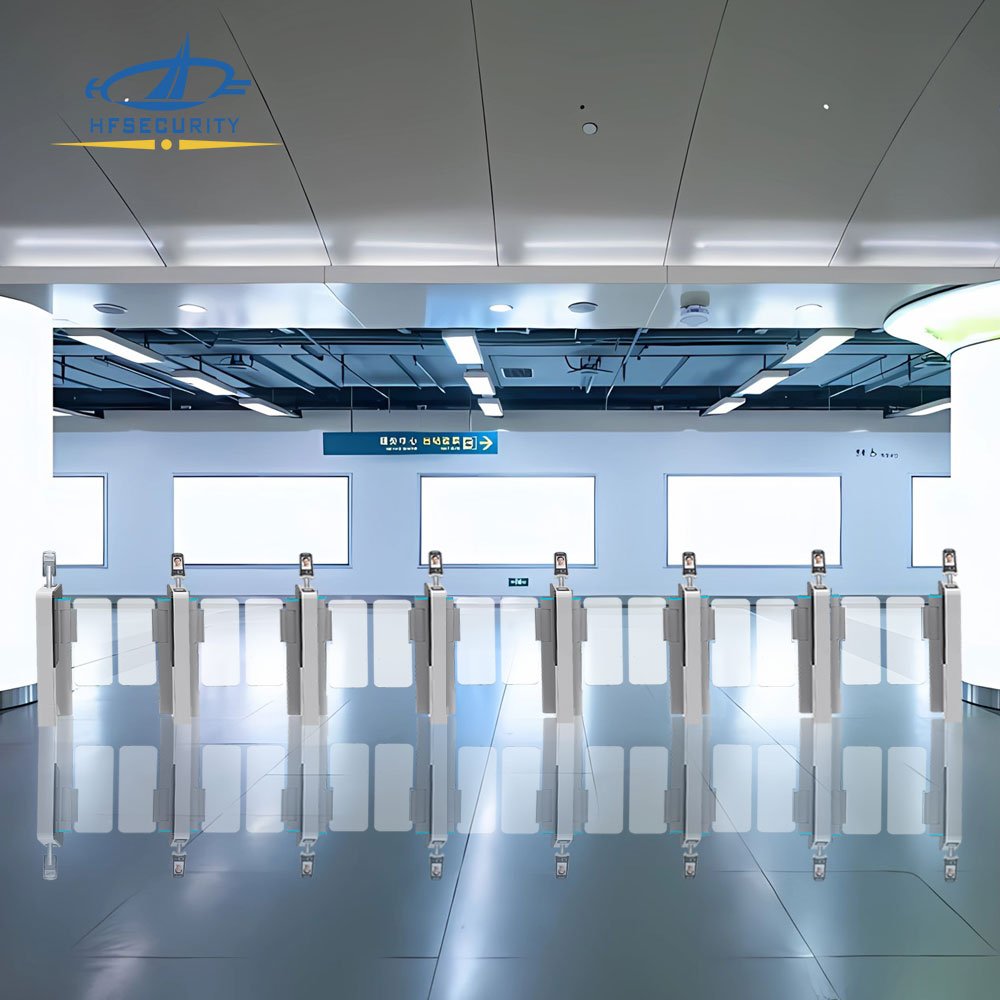Turnstile gates are mechanical or electromechanical barriers designed to control pedestrian flow by allowing one person to pass at a time through an access point. They serve both as a security checkpoint—restricting entry to authorized individuals—and as an efficient means to count and manage foot traffic in venues ranging from transit stations to corporate offices. There are several common types of turnstile gates—Tripod, Full-Height, Flap (Wing), Speed Gate, and Swing Barrier—each with unique features, components, and ideal applications. Modern turnstiles can integrate with advanced access control systems, including facial recognition, palm vein recognition, QR code scanning, and swipe-card readers, providing versatile security solutions tailored to varied environments.
Table of Contents
What Are Turnstile Gates?
Turnstiles (also called gatelines, baffle gates, or automated gates) are access-control devices that enforce one-person-at-a-time passage, often bi-directionally configured for entry and exit. They typically require a credential—such as a ticket, token, swipe card, or biometric scan—to unlock the barrier and permit access . From simple ratchet-mechanism stiles to sophisticated motor-driven arms with electromagnetic locks, turnstiles enhance security by preventing tailgating and providing accurate head-counts in real time Turnstiles.
Types of Turnstile Gates
Turnstile gates come in various forms suited to different security levels, aesthetic preferences, and throughput requirements. Below are the primary types:
Tripod Turnstile Gate
Tripod turnstiles are cost-effective and reliable access control solutions designed for areas with moderate security needs and high pedestrian flow. With their durable mechanical structure and compact design, they are widely used in office buildings, gyms, schools, and transportation terminals. Tripod turnstiles support various authentication methods such as RFID cards, barcodes, and biometric systems, making them a versatile choice for managing orderly and secure entry and exit.
Description & Components:
Features three rotating horizontal arms (stiles) mounted on a central hub.
May include electromagnetic locks and optical sensors in the housing to detect tailgating mairsturnstile.com.
Housed in a stainless-steel or powder-coated pedestal with control board, motor, and reader integration port nundnet.com.
Key Characteristics:
Compact footprint ideal for indoor use, Its slim and space-saving design makes it perfect for offices, schools, and other indoor environments where space is limited.
Moderate throughput (~30–40 persons/min), Efficiently manages medium traffic flow, ensuring smooth and orderly entry during peak hours without causing congestion.
Cost-effective with basic entry-level security, Provides a budget-friendly solution for facilities needing reliable access control without complex security requirements.
Applications of tripod turnstiles:
Office Lobbies:
Ensures only authorized staff and visitors enter, helping manage employee attendance and visitor access efficiently.Gyms and Fitness Centers:
Controls member entry, preventing unauthorized access while maintaining a smooth flow during busy hours.Event Halls:
Manages crowd movement by allowing moderate but orderly entry, ensuring security without slowing down access.
Full-Height Turnstile Gate
Full height turnstiles provide maximum security and complete physical separation, making them ideal for critical areas such as power plants, military facilities, and stadiums. Their rugged design deters unauthorized entry and supports biometric or card-based access control.
Description & Components:
Extends top-to-bottom, forming a full enclosure that prevents climbing or crawling underneath.
Constructed of tubular steel or stainless steel, often with three or four vertical sections.
Available with hand-cranked or motorized drive, electromagnetic lock options, and bidirectional logic control
Key Characteristics:
Maximum security deterrent against unauthorized entry.
Weather-resistant for outdoor installations.
Throughput of ~20–30 persons/min.
Applications of Full Height Turnstiles:
Power Plants and Energy Facilities:
Provide strong physical barriers to prevent unauthorized access, ensuring the safety and operational security of critical infrastructure.Military Bases and Restricted Zones:
Ideal for high-security military environments, offering strict access control and integration with biometric authentication systems such as facial recognition or fingerprint scanning.Stadiums and Event Venues:
Effectively manage large crowds while ensuring only ticketed or authorized individuals enter, enhancing both security and flow efficiency.Transportation Hubs (Airports, Train Stations, etc.):
Help control access to secure areas, prevent fare evasion, and integrate with smart ticketing or ID systems for seamless and secure transit operations.
Flap Turnstile Gate
Flap barrier gates combine fast access with elegant appearance, commonly used in corporate lobbies, hotels, and airports. They offer efficient crowd management while maintaining smooth, secure passage with support for various access technologies.
Description & Components:
Features retractable glass or acrylic panels (“wings”) that open and close horizontally.
Incorporates anti-pinch sensors, emergency-release, and anti-tailgating alarms.
Driven by a brushless DC motor with a control board and communication interface for reader modules.
Key Characteristics:
Sleek, modern design suitable for premium settings.
High throughput (up to 50 persons/min).
Enhanced safety with smooth, sensor-controlled panel movement.
Applications of Swing Barrier Gates:
Corporate Offices:
Enhance building security while maintaining a sleek, professional appearance. Ideal for employee access management using badges, face recognition, or fingerprint systems.Hotels and Hospitality Venues:
Provide a modern and elegant access solution for guests and staff, often integrated with room keycards or facial recognition for seamless entry.Airports and Transportation Centers:
Ensure efficient passenger flow and fast identity verification at entry/exit points, boarding gates, or lounge areas, balancing high security with quick access.
Speed Gate Turnstile

Speed gates are designed for rapid, touchless access in high-traffic areas like corporate campuses, metro stations, and tech parks. With a sleek modern design and advanced authentication support, they ensure efficient and secure flow for authorized personnel.
Description & Components:
Similar to flap barriers but optimized for higher speed using lightweight barriers and high-performance motors.
May include touchless activation via infrared sensors or optical turnstile detection beams
Key Characteristics:
Ultra-fast throughput (>60 persons/min).
Supports multiple authentication tokens (cards, mobile credentials, biometrics).
Low-profile design with customizable enclosure materials.
Applications of Speed Gates:
Busy Corporate Campuses:
Enable rapid, contactless access for employees and visitors during peak hours, improving efficiency while maintaining security.Metro Stations and Public Transit Entrances:
Designed for high passenger throughput, speed gates ensure smooth and fast entry/exit while supporting smart cards, QR codes, or biometric authentication.Tech-Focused Venues and Innovation Parks:
Perfect for environments that prioritize modern, intelligent access control systems—supporting facial recognition, palm vein scanning, and mobile credentials for a futuristic experience.
Swing Barrier Gate
Swing gates offer a stylish and practical access control solution, ideal for environments requiring wider passageways such as hotels, VIP areas, and facilities with accessibility needs. They support multiple identification methods and combine aesthetics with moderate security.
Description & Components:
Uses pivoting swing panels on hinges, integrated into housing with motor, sensors, and optional turn-style arms.
Often equipped with hydraulic dampers for smooth operation and safety sensors to prevent trapping
Key Characteristics:
ADA-compliant lane width.
Moderate throughput (30–40 persons/min).
Blends well in mixed-use environments.
Applications of Swing Gates:
Hospitality Venues
Offer a welcoming and stylish access solution for hotels, resorts, and exhibition centers, balancing aesthetics with functional entry control.VIP Lounges and Executive Areas
Provide smooth and elegant access for high-end spaces, supporting multiple authentication methods such as RFID, QR codes, or biometrics.Accessible Lanes in Public and Private Facilities
Ideal for creating wider lanes for wheelchair users, strollers, or luggage carts, while maintaining moderate security and controlled access.
Components Common to All Turnstile Gates
Housing & Framework: Stainless steel or powder-coated steel for durability and aesthetics.
Drive Mechanism: Manual ratchet, brushless DC motors, or hydraulic systems.
Barrier Arms/Panels: Steel stiles, glass wings, or swing panels.
Control Board: Central logic with configurable entry/exit rules and communication ports.
Reader Integration Ports: Support for RFID readers, biometric scanners, QR-code modules, and PIN pads.
Safety Sensors: Infrared beams, anti-pinch, and anti-tailgating detection.
Emergency Release: Fail-safe modes and fire-alarm integration to unlock barriers instantly.
Applications of Turnstile Gates
Turnstile gates are versatile and find use across multiple sectors:
Mass Transit: Subway stations, bus depots, and train terminals to validate tickets and prevent fare evasion.
Corporate & Commercial Buildings: Employee access management integrated with HR systems and visitor management HFSecurity Turnstiles.
Stadiums & Arenas: Ticket verification, crowd control, and accurate attendance counting Turnstiles.
Secure Facilities: Power plants, data centers, and defense installations requiring high-security perimeter solutions.
Educational Campuses: Student and staff identification, enhanced safety, and attendance tracking.
Healthcare & Labs: Controlled access to sensitive areas, ensuring only authorized personnel enter cleanrooms or labs.
Residential Complexes: Gated communities and high-rise residential lobbies for resident and guest access control.
Integration with Access Control Systems
Modern turnstiles seamlessly connect to advanced access control technologies:
Facial Recognition: Cameras and AI-driven software identify individuals within milliseconds, unlocking barriers without contact HFSecurity.
Palm Vein Recognition: Infrared scanning of subcutaneous vein patterns provides a highly secure biometric credential.
QR Code Recognition: Mobile-based passes scanned via integrated optical readers—ideal for event ticketing and guest access.
Swipe-Card & RFID: Classic credentials (MIFARE, proximity cards) read by embedded modules to grant entry.
Mobile & NFC: Smartphones and wearables act as credentials for touchless authentication.
These integrations allow turnstiles to fit into comprehensive security frameworks—linking attendance software (e.g., HFIMS), CCTV, and building-management systems for unified monitoring and reporting.
Related demonstration videos
Conclusion
Turnstile gates are critical components of modern access control strategies, offering tailored security, efficient pedestrian flow management, and accurate attendance tracking. By understanding the distinct features and applications of each type—Tripod, Full-Height, Flap, Speed, and Swing Barrier—organizations can select the optimal solution for their environment. The ability to integrate facial recognition, palm vein scanning, QR-code reading, and traditional swipe-card systems further enhances flexibility, making turnstiles indispensable in today’s security-conscious world.















